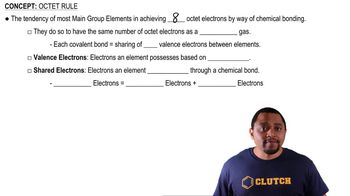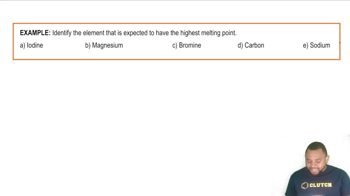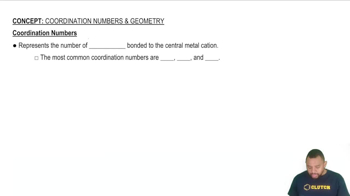(a) Which of these compounds is an exception to the octet rule: carbon dioxide, water, ammonia, phosphorus trifluoride, or arsenic pentafluoride?
Ch.8 - Basic Concepts of Chemical Bonding

Brown14th EditionChemistry: The Central ScienceISBN: 9780134414232Not the one you use?Change textbook
Chapter 8, Problem 62
For Group 13–17 elements in the third row of the periodic tableand beyond, the octet rule is often not obeyed. A friendof yours says this is because these heavier elements are morelikely to make double or triple bonds. Another friend ofyours says that this is because the heavier elements are largerand can make bonds to more than four atoms at a time.Which friend is more correct?
 Verified step by step guidance
Verified step by step guidance1
insert step 1> Consider the octet rule, which states that atoms tend to form bonds until they are surrounded by eight electrons in their valence shell. This rule is most applicable to the second row elements.
insert step 2> Recognize that for elements in the third row and beyond, the octet rule is often not strictly followed. This is due to the availability of d orbitals, which can accommodate more than eight electrons.
insert step 3> Evaluate the first friend's statement: Heavier elements can form double or triple bonds. While this is true, it is not the primary reason for the octet rule's exceptions. Double and triple bonds are more about bond strength and stability rather than exceeding the octet.
insert step 4> Evaluate the second friend's statement: Heavier elements are larger and can bond with more than four atoms. This is more accurate because larger atoms have more available orbitals (including d orbitals) that can participate in bonding, allowing them to expand their valence shell beyond eight electrons.
insert step 5> Conclude that the second friend is more correct. The ability of heavier elements to expand their valence shell and form bonds with more than four atoms is a key reason why the octet rule is not strictly followed for these elements.

Verified video answer for a similar problem:
This video solution was recommended by our tutors as helpful for the problem above.
Video duration:
3mWas this helpful?
Key Concepts
Here are the essential concepts you must grasp in order to answer the question correctly.
Octet Rule
The octet rule is a chemical guideline that states atoms tend to bond in such a way that they each have eight electrons in their valence shell, achieving a stable electron configuration similar to that of noble gases. While this rule is applicable to many elements, particularly those in the second period, it becomes less relevant for heavier elements in groups 13-17, which can exceed eight valence electrons due to their larger atomic size and available d-orbitals.
Recommended video:
Guided course

Octet Rule
Bonding in Heavier Elements
Heavier elements, particularly those in the third period and beyond, can form multiple bonds (double or triple) and can also utilize d-orbitals for bonding. This allows them to accommodate more than four bonds, leading to complex bonding scenarios that do not conform to the octet rule. The ability to form such bonds is influenced by their larger atomic radii and the presence of additional electron orbitals.
Recommended video:
Guided course

Main Group Elements: Bonding Types Example
Coordination Number
The coordination number refers to the number of atoms or ions immediately surrounding a central atom in a complex or coordination compound. For heavier elements, the coordination number can exceed four due to their larger size and the availability of d-orbitals, allowing them to bond with more than four atoms simultaneously. This characteristic is crucial in understanding the bonding behavior of these elements and their ability to form various molecular geometries.
Recommended video:
Guided course

Coordination Numbers
Related Practice
Textbook Question
Textbook Question
(b) Which of these compounds or ions is an exception to the octet rule: borohydride (BH4-), borazine (B3N3H6, which is analogous to benzene with alternating B and N in the ring), or boron trichloride?
Textbook Question
Draw the Lewis structures for each of the following molecules or ions. Identify instances where the octet rule is not obeyed; state which atom in each compound does not follow the octet rule; and state how many electrons surround these atoms: (a) PF6-, (b) BeCl2, (c) NH3, (d) XeF2O (the Xe is the central atom), (e) SO42- .
Textbook Question
In the vapor phase, BeCl2 exists as a discrete molecule. (a) Draw the Lewis structure of this molecule, using only single bonds. Does this Lewis structure satisfy the octet rule?
